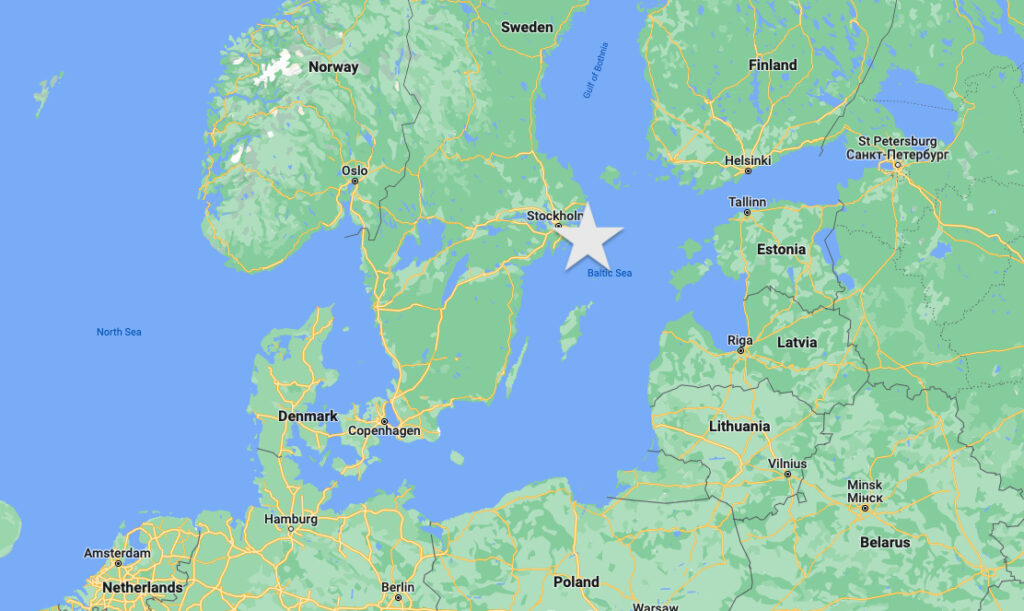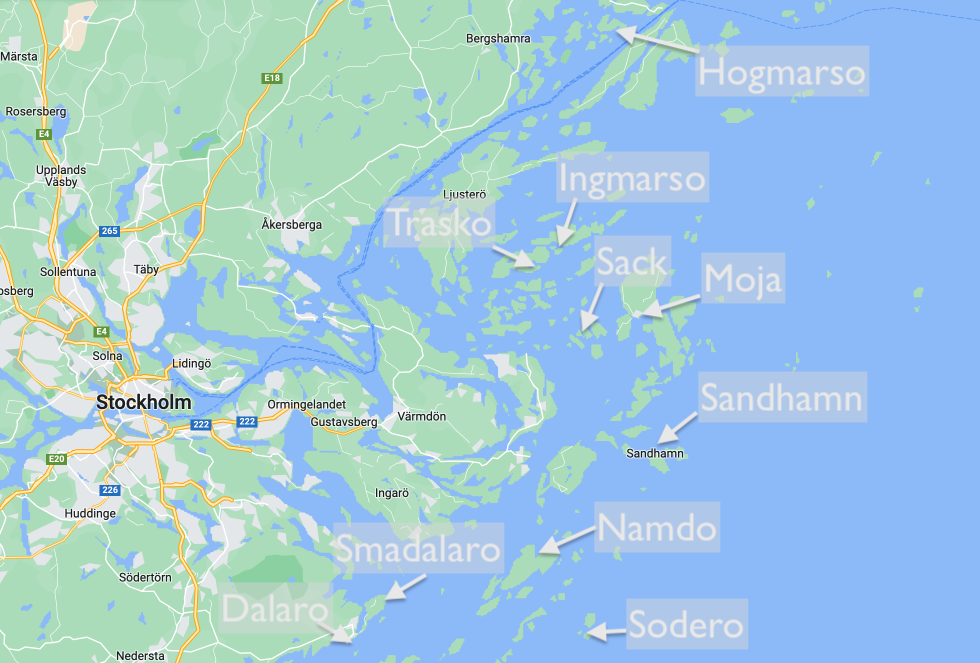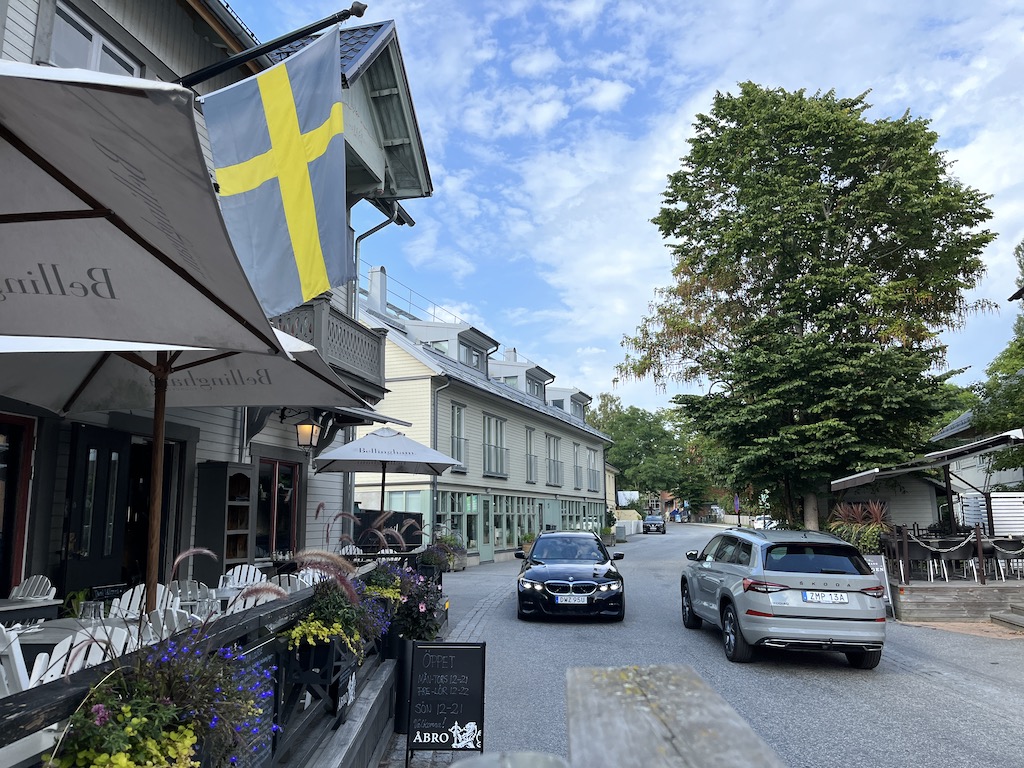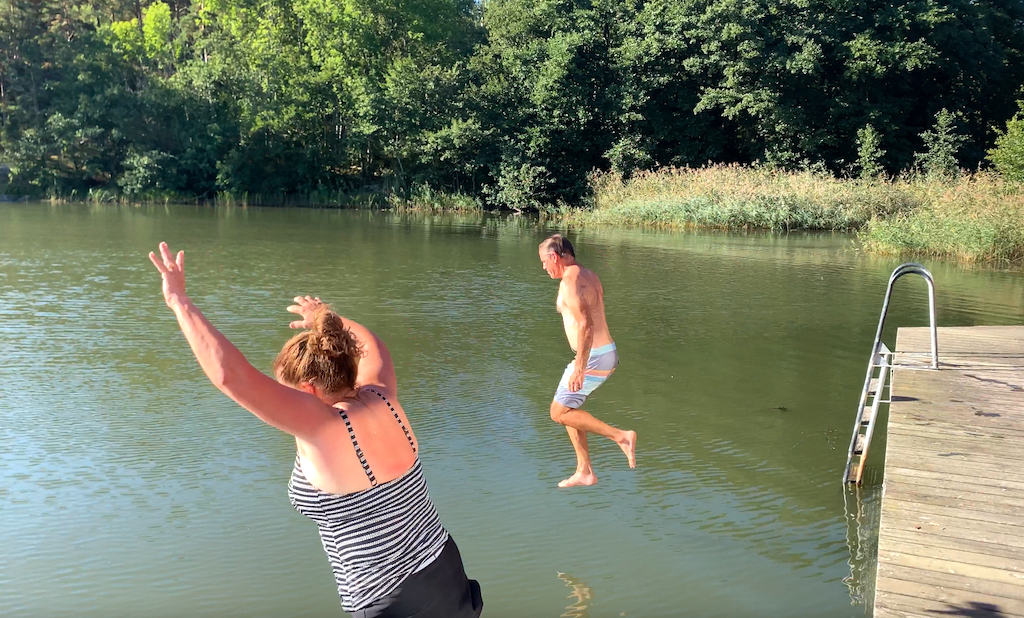It felt good to be back in the familiar waters of Sweden. As the days headed into mid-August, we had the advantage that family boaters had already sailed back to their home ports, along with most everyone else in that strange seasonal phenomenon where adults without school-aged children also assumed it was the end of summer, in a seemingly sympathetic gesture. But as much as we all enjoy outsmarting the crowds on vacation, it can also be alarming to travel completely alone. I find myself second-guessing decisions. Is there no one here because of some warning of danger that we missed? Is it too cold to enjoy the outdoors, in a country headed towards severely limited winter daylight? Will all of the fun sites exalted in the cruising guides still be open? In our favor, to fend off any loneliness, we had the joy of hosting three different groups onboard Sea Rose in these last remaining weeks before our haulout. In anticipation, Karen and I hurriedly scoped out several of the most interesting islands in the Stockholm archipelago before picking up our son Zack and his two college friends Andrew (whom you might remember from our travels in Croatia) and Evan for a week of island hopping. After dropping them off, we planned to welcome my niece Julia and her friend Mary from Ireland onboard, followed by our friend Patty (a regular crew member from our travels in Mallorca and Croatia) and her boyfriend Patrick.


The Stockholm Archipelago is a crazy maze of 25,000 to 100,000 islands, depending on how you define an “island”. The city of Stockholm itself is some 30 miles inland through this archipelago from the open waters of the Baltic Sea, with the islands serving as a summer playground for cottage owners, boaters, and city dwellers seeking fresh air and a change of venue. But it is not like Bostonians traveling to Cape Cod, North Carolinians to the Outer Banks, or Vancouverites to Victoria. The scale is completely unimaginable. We met a Swedish boater in his 70’s in Fejan who proudly spoke of sailing throughout the archipelago since he was a young child. Still, he had not heard of one of our favorites, the artistic hamlet of Bullero. And I could not fault him, for there are countless treasures like these awaiting the senses.
I’m trying a new approach to our blogging for this end of the season recap. I am going to highlight our favorite boating destinations in the area. Call it ‘Toms Top 10 Destinations in the Stockholm Archipelago’! They will give you an idea of the beauty and breadth of this region of the Baltic. So here goes, in order from North to South:
Hogmarso
The island of Hogmarso has a hippy vibe, centered around a repurposed shipyard with rusty cranes and brick warehouses roofed with fading sheet metal. The shipyard is now home to an outdoor restaurant with generous views of a harbor filled with old commercial and military vessels, most of which are in heavy need of TLC. We anchored in a quiet harbor on the opposite side of the island, taking our paddle boards out to explore the wildlife amongst the tall reeds along the shore. We found a blue heron hiding out in the reeds. They are anxious creatures, taking flight at the slightest decibel of non-native sound, making the photography of them an allusive goal. To reach the shipyard, we launched the dinghy and circled the island, only to find out that our uncooperative dinghy was starting to leak water, again, at the same seam I had repaired back in Kalmar. I had gotten in touch with a Highfield dealership in Stockholm earlier in the summer and it was time to reconnect! He got a dinghy order from us that day. It was time to sign off from this one-way relationship. I had spent too many days patching the hull-to-tube seam over the last three years – we would be moving on!



Ingmarso
Heading south into the center of the archipelago, the guest harbor at Ingmarso held the promise of a grocery store and protection from upcoming strong winds and rain. We stayed two nights with Zack, Evan and Andrew, taking trips away from the dock in paddle boards and the dinghy to sightsee during breaks from the rain. It was a good introduction to the life and the people of the archipelago. First of all, nearly everything closes down in early August, as kids go back to school. We had received an inkling of this phenomenon on Hogmarso, as Karen and I grabbed armfuls of goods at the grocery store before their seasonal close, in a manner similar to looters during a big city blackout. Here in Ingmarso, the grocery store was open for a few more weeks, but was sparsely stocked. For our planned barbecued hamburger dinner, we could find charcoal but no lighter fluid. This led to an entertaining debate between three UC Berkeley graduates on how best to use the limited and heavily moist twigs around the harbor to match the high heat output of petrochemicals. Back at the dock, no less than three boats with all women crews pulled in under a menacing sky. They wore the look like this was a normal day out on the water, as we huddled under our bimini-protected cockpit. Zack and I gave a hand to a crew of three women that had to be pushing 80 years old, decked out in their foul weather gear and inflatable lifejackets. I was impressed, but then again, I could easily picture my mother doing the same at 80 if she were still alive.
The interior of Ingmarso was crisscrossed with dirt roads and informal hiking trails, heavily greened over from the recent precipitation. But that didn’t dissuade a bride and groom from sneaking in a reception before the onset of winter. This was a hearty bunch of people, ready to seize the day.



Trasko
A fellow sailor had tipped us off to a nice restaurant on the island of Trasko, a short distance from Ingmarso. Down a long channel of water, and past the point of depth soundings on the chart, we carefully approached the guest dock at Bistro Sagen. We tried tying the stern buoy to our midship cleat to keep us off of the dock and avoid the shallow slab of rock that protruded just below the surface from the shore – clearly, they were more accustomed to smaller boats here! With only a few widely-spaced tables at the cafe, all but one empty, reservations seemed unnecessary. Then, boat after boat arrived with full families in tow and young couples pushing strollers appeared like characters out of the corn rows from Field of Dreams as they navigated to Bistro Sagen from unknown locations inland. Following the theme of “If you build it, they will come”, three enterprising women had founded this restaurant a few years ago with a mission: help this island thrive. One of them had grown up on this land when it was an active saw mill. Trying to protect the businesses from disappearing, they formed a partnership to produce good food from local island ingredients in a manner that could support work for others year round. The property was filled with rustic artifacts from its sawmill past, but updated to include a large solar array and the ability to have regularly scheduled live music. Equally appealing as the delicious menu options was the opportunity to reserve the sauna in a decadent three hour time block. It served as a good introduction for Zack, Andrew and Evan to sauna life and the soothing affect of a hot wood fire interspersed with dunks in the cold harbor water.


Sack
Just a few short sailboat tacks away from Trasko is the unique, nearly circular nature harbor of Sack. Along the way, it was hard to miss the many bright white flag poles, as tall as the tallest surrounding pine trees, flying the Sweden flag. It seemed unusual to find an island cottage without a flag pole. Sometimes they would fly a long narrow pennant-style flag, like something from a Renaissance Faire, but my favorite was the traditionally shaped Sweden flag.

The entrance to Sack is not for the faint of heart. The charted depth just before entering the circular pool was 2.4m. With our draft of 2.2m, that left us just 20cm or about 8 inches under the keel. Pleasingly, either due to changes in the bottom contour or a wind-whipped tide, the shallowest reading we encountered was a slightly more generous 50cm under the keel. As we cleared the entrance, boats were spread out around the perimeter of the pool, tied mostly bow into the rock as they so commonly do here in the Baltic. We chose the alternate option of anchoring in the middle, where our comfort zone laid. This approach seemed reasonable until the wind started an early 90 deg shift to its forecasted direction for the overnight. A man on a neighboring boat, when he started to swing into us, responded that he had a 2:1 scope out and ‘the best anchor for this place’. I wasn’t sure what the later comment meant, but I surely knew a 2:1 scope meant he was not dug in and would certainly drag. In the pecking order of anchoring, it was customary for us to move since he was here first, but we pushed our luck and ended up with an evening so calm, all of the anchor lines in the harbor hung benignly down directly over their anchors. I counted 28 boats in this little pool, an amazing feat of engineering, as well as social responsibility. Only the faintest of voices could be heard, as our neighbors finished their dinners and silently absorbed the beauty of a star-filled sky.

Moja
Another short 5 mile hop away, the harbor of Moja (MOW-jah) held the possibility of bike rentals, restaurants and the ever elusive grocery store. With Zack and friends, we pulled into an empty harbor. None of the three guest harbor docks were occupied. We nosed in slowly to the closest one, noting the preponderance of sea weed at the surface, leading down to shallow rocks. Throwing caution to the wind, we tried the Baltic approach of dropping a stern anchor on the way in, hoping to get a person onto the dock in time to both slow the boat down and avoid running aground on the long slabs of rock projecting from the shore. With five hands onboard, this kind of maneuvering is far easier than when Karen and I try it alone.
Ashore, the grocery store had closed for the season, bike rentals that were co-located at the youth hostel looked shuttered, and only one restaurant was open for business. Still, traditional red painted cottages covered the wavering shoreline on the short walk to dinner. Our server, a polite young Swede that, ran through the limited evening menu. Swedes, despite their quieter nature, can be extremely proud and stoic. When I remarked that they must be happy the peak of Covid is over and customers are returning, he sternly replied that the two prior years were some of the best the restaurant had ever had. It seems that Swedes love to travel south to warmer climates in the summer. But with Covid, most Swedes stayed near home, giving restaurateurs like this one a boost in revenue, particularly as Sweden chose not to enforce strict lockdowns and mask rules. So, by our arrival after peak season and also after peak Covid, the restaurant should have be excited to seat a table of five. Our server remained stoic.
Just 10 days earlier, Karen and I had made a short stop here to scope out the surroundings before our guests arrived. All the restaurants were in full swing, fully booked, and there was no room at the guest docks for one more boat, forcing us to anchor out. The difference in a little more than a week’s time was striking.

Sandhamn
For yet another perspective on the Stockholm archipelago, one must visit Sandhamn (literally, Sand Harbor). Situated as it is on the outer periphery of the archipelago, this collection of islands could easily have remained in its natural state like the outpost at Bullero. But instead, it was a beehive of activity. Given its proximity to the Baltic and the commercial shipping routes leading into Stockholm, things on Sandhamn got going in the 17th century with the formation of a maritime pilot station on the island. Sand was later sold from the island for ship’s ballast. Today, with the establishment of the Royal Swedish Yacht Club (KSSS), Sandhamn’s main claim to fame is the annual Gotland Runt, a 250 boat sailing regatta that starts in Stockholm, rounds the island of Gotland, and ends at Sandhamn. Like a Newport or Les Sables-d’Olonne of Sweden, sailing is the heartbeat of the island.


But there is more to this island group than just fancy, go-fast sailboats. In 1938, Sweden passed a law requiring employers to grant two weeks of paid holiday to all employees (today, it is five weeks). This brought workers and the middle class to destinations like Sandhamn, even if they could only afford to rent a small cottage. On the southern end of the island, the simple resort community of Trouville was staked out in 1946, with cottages limited to 35 sq meters (375 sq ft) to appeal to these new holiday makers.
Across the harbor, the island of Lokholmen was home to an eccentric businessman, Kurt Heinecke, who in 1914 built, among other odd structures, a stone observatory which we toured after my niece Julia and her friend Mary took over for crew onboard Sea Rose. Sandhamn has excellent ferry connections to the mainland and Stockholm and makes for a superb location to switch crew.


Namdo
Changing up the pace once again, we took Julia and Mary to the harbor of Namdo, where no yacht clubs or fancy restaurants nor even ferry service were available. In its absence was seclusion and quiet. The perfect therapy. Especially when you pair it with a rustic wood-fired sauna on the shore, provided as a courtesy by the Archipelago Foundation. This sauna seemed to typify the true Sweden cruising experience that we had read about. You sail into a quiet harbor, anchor or tie bow to a rock, go ashore and start your own fire in the stove from nearby chopped wood and kindling. Fifteen minutes later you are soothed by the intense heat and the wood fire aromas, and it’s time to cycle back and forth to the water for a cooldown dip. Simple, refreshing, and a bond with nature.
Just before dusk we were treated to the arrival of a fleet of old wooden sloops, skillfully piloted by captains who knew exactly when to douse the sails so they would coast into the rocky shore with just enough speed to drop their spouse off with the bow lines. It was impressive seamanship, matched only by the beautiful craftsmanship they had invested to keep these historical vessels afloat.




Sodero
Julia and Mary showed a strong preference for nature and the wildlife it supports. They had met at a summer camp on a lake in the rural, wooden region of Maine, a state with vast pine forests and abundant water and coastlines. So we should have known that the island of Sodero, with its preponderance of small stone islands, the kind that you could walk the breadth of in 1-2 minutes, appealed to their back-to-nature instincts. Here, the paddle boarding options are endless, leading you on a twisting course with the only risk that you could get easily lost were it not for Sea Rose’s tall mast sticking up like a homing beacon. We identified one small island with an clear stone summit just taller than the surrounding trees, giving us a clear sight to an orange-hued horizon as the sun set and blue herons swept gracefully across the sky for another idyllic Swedish day in the archipelago.


Dalaro
Julia and Mary’s schedule only allowed for a few days onboard. Visitors to Sea Rose often combine their sailing with before or after land travel (hedging their bets in case the food and entertainment suffers!) We chose the mainland harbor of Dalaro for its convenient guest harbor and connections inland to drop them off; and while there we found the town itself to be charming and perfect for stocking up on fresh-baked bread and provisions from a luxurious choice of not one but two open grocery stores.


Smadalaro
Right around the corner and with a very similar name, the tiny harbor at Smadalaro is a real challenge to enter. Friends had told us to keep the boat no more than 1 meter away from the stake on the shore. Without even seeing the stake yet as we approached, 1 meter seemed too close to hard ground. But the advice was spot on. We just had to pay very close attention, which was not easy as we passed the grand mansion of Skype founder Niklas Zennstrom on the way in, with its expansive green lawns leading down to a dock with big sauna buildings and go-fast boats. Small underwater ledges protruded from both shorelines at the narrows. With one meter on the port side, and just a few meters from shore on the starboard side, we gently motored through and entered a flat, calm pool that felt more like a small, enclosed lake. Our destination was the long guest dock at the resort and spa named Smadalaro Gard. Our friends Patty and Patrick had just boarded and we felt it was important for them to get a glimpse of the swanky side of Sweden. Oh, and it was also our 30th wedding anniversary. I assure you the spa idea was all for our guest’s benefit though! The resort had a hedonistic three hour spa program, and it quickly turned into four adult children trapped in a candy store. Smadalaro Gard provided three different sauna experiences – one moderately warm, one hot, and one so humid and foggy with steam that you couldn’t even see people sitting right next to you. In between saunas, they offered a bucket drop of cold water to shock your nervous system. This was followed by an optional meditation room with cordoned off futons lined with overstuffed pillows all separated by heavy cloth floor-to-ceiling curtains in the fashion of a scene from Casablanca and only lacking a giant waving banana leaf for air circulation.
Wrapping up our spa day with a splash in the indoor/outdoor jacuzzi, my only worry was, given that this had been Karen’s idea originally, how I would top it for next year’s anniversary. This might come as a surprise, but being married can be stressful, especially after 30 years!




With Patty and Patrick suitably acclimated, we put Smadalaro to our stern as we headed south out of the archipelago and on to new adventures on our way south to Kalmar.

I hope you enjoyed the tour of my top 10 destinations in the Stockholm Archipelago. There is tremendous variety to choose from in this sailing region, buoyed by historical sites, impressive wildlife, saunas around every corner, and an exhaustive list of paddle boarding options. Just make sure you provision well beforehand!
Be sure to also checkout the video content on our LifeFourPointZero YouTube channel. We regularly post updates on our sailing adventures, as well as how to videos on boat repair, sailing techniques, and more!

